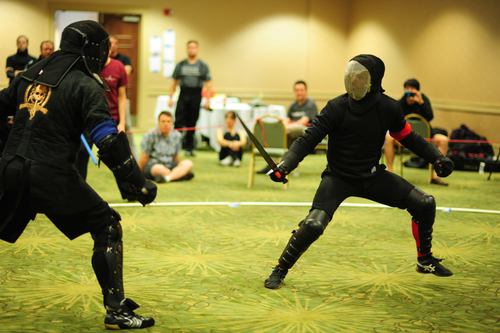
This is a re-edit of an article I originally wrote in August 2014.
Abbreviations
BpE – bilateral-hits per exchange, averaged over the tournament. This includes doubles and afterblows.
RAS – Relative Afterblow Strength. Something which subtracts 1 from the initial hit is a low RAS, whereas a full negation is a strong RAS.
Axioms
1) Once the initial hit has landed, the fighter who was hit is fully committed to landing the afterblow regardless of the strength of the afterblow rules. They have nothing to lose and everything to gain. Likewise, at the moment of impact the attacker now has nothing to think about other than defending the afterblow.
Which leads to:
2) The ability of a fighter to land an afterblow is only a function of the position* both fighters find themselves in at the time of the initial hit, not the rules.
This leads us to:
3) A statistically relevant difference in BpE between tournaments with different RASs can only be the result of behavior before the initial strike makes contact**. For doubles it’s fairly obvious that the behavior immediately before the double is the cause.
* In this case ‘position’ takes into account things such as momentum and mental focus. Configuration would be a more accurate, but harder to follow, term.
**assuming that other variables, such as audience participating, are controlled. This is often not a safe assumption to make.
Extrapolation
Since only actions before the initial hit can affect the BpE, it means that the BpE is a function of the attacker’s commitment to try attack in a safe manner (Attacker Mitigation: AM), and the opponent’s propensity for putting themselves in a position to land an afterblow when they are hit by an attack. (Defender Maximization: DM).
We can look at both of these as functions of the strength of the afterblow rule. AS(RAS), (for those of you who loved algebra back in school) is the way in which the attacker’s behavior modifies to be safer as the strength of the afterblow rules increase. So we would expect to see attacks that engage the blade better, or attacks taking into account measure and tempo for a withdrawal.
The Defender Maximization of the afterblow rule can also be modeled as a function of the afterblow strength. DM(RAS) could be expected to increase over time. If there is no afterblow rule then only the most ‘differently socialized’ of fighters would adopt fighting strategies to maximize their chances of hitting their opponent back after the initial hit.
- As RAS increases we can expect that the attacker’s commitment to attacking safely will either remain constant or increase, but not decrease.
- As the RAS increases we can expect that the defender’s fighting style will either remain constant or change to increase their probability of landing an afterblow, but not decrease it.
Now if we want to model BpE as we vary the strength of the afterblow rule, it will look like some sort of function that causes BpE to increase as AM increases, and decrease as DM changes to exploit the rule better. We have already described that AM(RAS) should either remain constant or decrease as we increase RAS. This would show that the number of afterblows decrease as the strength of the afterblow rule increases.
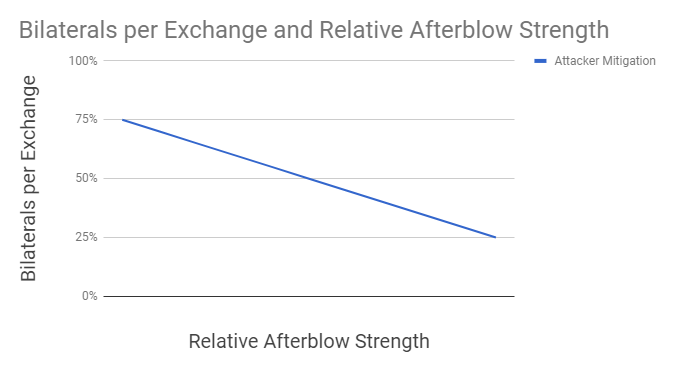
Now we also have to consider that defenders are modifying their game in order to take advantage of the afterblow more effectively. The number of recorded afterblows should either remain constant or decrease as the strength of the afterblow rule increases.
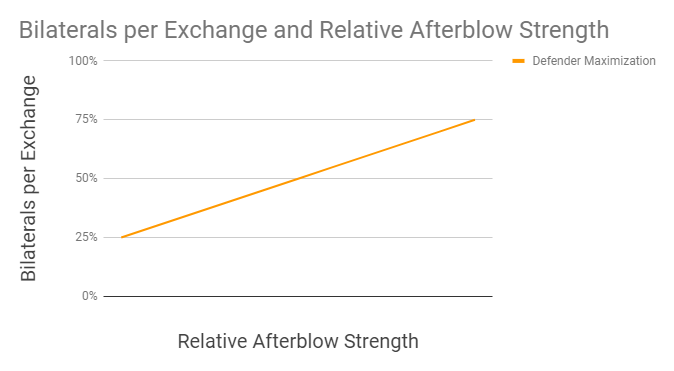
By combining the two factors we get the total BpE for the tournament.
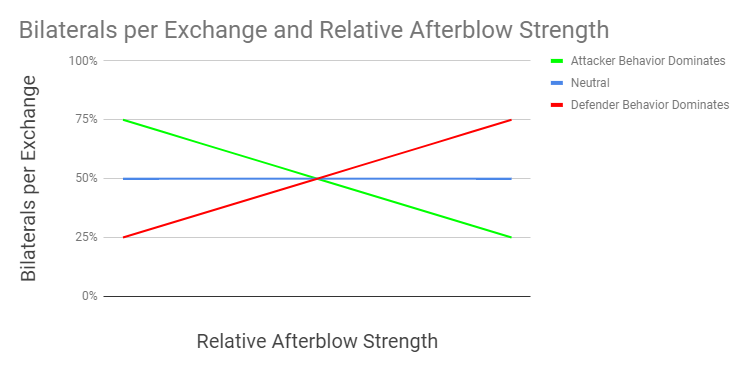
If the defender behavior is not altered we should see behavior resembling the green line. If defender and attacker behavior is altered equally we should see something resembling the blue line, and if the defenders change their behavior more than the attackers the trend will resemble the red line. (Of course they won’t be nice and linear like this, but you get the idea.)
Hypothesis
- If the BpE decreases with stronger afterblow rules, it indicates that the strength of the afterblow rule successfully compels fighters to control their opponent’s actions when they attack. (This is the goal of the afterblow rule)
- If the BpE does not vary with the strength of the afterblow rule, it means one of two things: The propensity of the attacker to attack safely increases at the same rate as the defender’s propensity to exploit the rule, or that the strength of the afterblow rule does not influence the behavior of the attacker and the defender.
- If the BpE increases with stronger afterblow rules, it indicates that stronger afterblow rules cause more of a change in defender’s behavior, allowing them to better exploit the rule (Most certainly not the goal of the afterblow rule).
Empirical Results
Now, as fun as it to talk theory we don’t have anywhere close to a statistical data set to actually evaluate this. But just for fun I ran the numbers from LP 2012, 2013 and 2014 open longsword which are available in their entirety. Many thanks to Ben Jarashow.
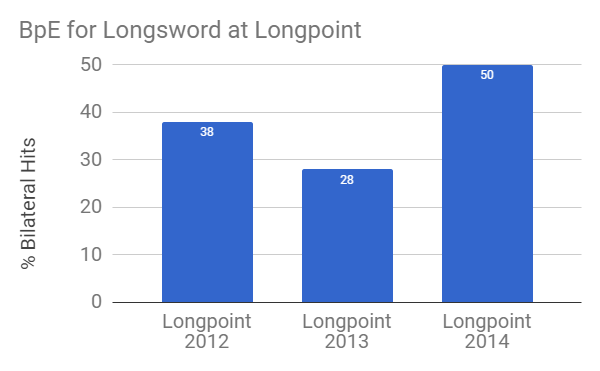
For those of you who don’t know, LP12&13 used a relatively strong afterblow system, but still weaker than full negation, and LP14 used a fully weighted afterblow.
This is just data on one event, but it shows that either:
- The introduction of a Fully Weighted Afterblow did not encourage fighters to attack in a safer manner.
- If the Fully Weighted Afterblow caused fighters to try to attack in a safer manner, then their opponents adopted fighting styles which caused them to be in better positions to exploit afterblows.
Notes for the updated version
I’ve learned more about tournaments and data mining since I originally wrote this. I have a ton more data available for weaker afterblow rule sets, however I don’t have a lot of information from rule sets with strong afterblow rules. This is a shame as it’s not like there are a dearth of them out there. 😉
The data I have from tournaments with lower RAS agree with the trend to lower BpE. All I have from Full Afterblow tournaments are the numbers I jot down when I watch matches on YouTube. While this isn’t a very rigorous sample, it does tend to agree with this trend. I look forward to having more information in the future.

